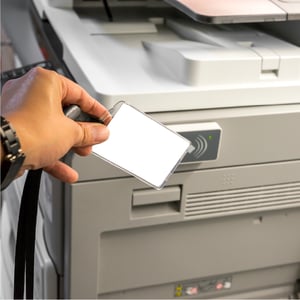According to Quorica’s 2022 Global Print Security Landscape Report, 68% of IT decision-makers from small to midsize businesses reported that they experienced data losses due to unsecure printing practices. To make matters worse, each breach cost an average of $780,857 (£631,915), largely due to customer loss.
If you haven’t taken steps to secure your print fleet, it’s time to bump it up the priority list. But since print security is a relatively new component of overall cybersecurity hygiene, let’s make sure we’re all up to speed on the basics.
What Is Print Security?
Print security refers to the practice of securing your printing devices as well as your printed materials. Here’s where it can get a little bit confusing: Secure Printing, also called Follow Me Printing or Pull Printing, refers to security features that require user authentication at the printer before a document is produced. Secure printing is just one component of proper print security.
Why Is Print Security Important for Network Security and Data Protection? 
Modern printers have many of the same vulnerabilities as laptops and smartphones — they use hardware and software, have memory, and are also connected to your network. Unfortunately, without the protection that is frequently given to other networked devices, printers can serve as a potential entry point for hackers.
Top Printer and Document Security Vulnerabilities
Abandoned Documents
Have you ever found something confidential left unattended in a copy machine or printer tray? Quora users offered up a few shocking examples of documents they’ve found there: a background check on a co-worker, plans to eliminate an entire department, salary information, and much more.
Approximately 30% of documents are never picked up from the printer at all. That’s wasteful, but should any of those documents contain anything confidential, printer forgetfulness is a significant security concern. Without proper print security in place, it’s very easy for other employees to take documents that don’t belong to them — either intentionally or accidentally.
Improper Decommissioning
Most modern printers have a memory, and when you’re done using them, you need to make sure any data is unrecoverable before you send your printer to the scrapyard.
Just two years ago, a regional health center had to notify 101,395 patients that improper decommissioning may have exposed sensitive information, including social security numbers, financial information, test results, passwords, and more to hackers. As of 2023, the fine for a single tier one HIPAA violation can be up to $50,000, but even if your business doesn’t need to meet regulatory compliance, print security negligence can cause a PR nightmare.
Manipulation of Printer Settings
40% of IT professionals admit they don’t always change default admin passwords. A default admin password is one way a hacker could gain access to your printer’s controls. Depending on your printer’s capabilities, from there, a hacker could erase data, view printed documents, forward copies to an email address or a server, access internal email lists — or potentially your entire network. And that’s the absolute tip of the iceberg that is configuration management and device hardening.
Network sniffing
Hackers can use something called a packet sniffer or network sniffer to capture data while it’s being sent back and forth. If your print drivers, users, and workflows for scan and print technologies aren’t using a solution with encryption in transit, bad actors can access the confidential information en route fairly easily.
Unpatched Firmware
At the device level, firmware-based vulnerabilities take many shapes and sizes. Some devices that are often overlooked from a patching perspective may live within an organization’s networks for five, ten, 15, or even 20 years! That’s a long time to accumulate vulnerabilities and antiquated or insecure protocols.
Infrastructure Security and More
Heard of PrintNightmare? This printing-related (Windows print spooler service) vulnerability allowed potential attackers to quickly and easily become domain administrators, where they could start using code to cause all kinds of mayhem.
This vulnerability did not affect print devices directly. Instead, it emphasized the importance of a holistic approach to security across an entire network.
Our Tips To Enhance Print Security for SMB Business Owners
Small to midsize businesses don’t have to go it alone when it comes to print security. A security-forward Managed Print Services provider can help you set up secure printing practices throughout your organization to prevent snooping and document theft while reducing print costs and waste.
But some providers can offer a lot more…
At Marco, we also include print security services as part of our regular offering. Our secure-by-default approach includes upfront device hardening and decommissioning data sanitization practices (multi-pass overwrites). Plus, we have a dedicated print security team that is constantly on the lookout for emerging print-related cybersecurity threats!
Finally, you don’t have to wonder whether or not we’re consistently following best practices: we have achieved a SOC 2 Type 2 report for our managed IT and managed print services, and we’d love to share it with you.
If you’re interested in identifying risks in your print environment, we’ll provide a comprehensive print security assessment at no charge. Contact your Marco representative today, and tell them Jay Brown sent you!
